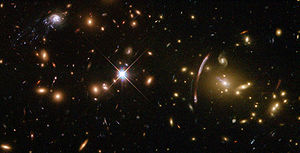Abell 2667
Appearance
| Abell 2667 | |
|---|---|
 Abell 2667 from Hubble Space Telescope. Comet Galaxy is top-left (blue). | |
| Observation data (Epoch J2000) | |
| Constellation(s) | Sculptor |
| Right ascension | 23h 51m 42s[1] |
| Declination | −26° 00′ 00″[1] |
| Richness class | 3[2] |
| Bautz–Morgan classification | I [2] |
| Redshift | 0.23000[3] |
| Distance | 927 Mpc (3,023 Mly) h−1 0.705 [3] |
Abell 2667 is a galaxy cluster. It is one of the most luminous galaxy clusters in the X-ray waveband known at a redshift about 0.2.
This cluster is also a well-known gravitational lens.
On 2 March 2007, a team of astronomers reported the detection of comet galaxy in this cluster. [4] This galaxy is being ripped apart by the cluster’s gravitational field and harsh environment. The finding sheds light on the mysterious process by which gas-rich spiral-shaped galaxies might evolve into gas-poor irregular- or elliptical-shaped galaxies over billions of years.
See also
External links
- Hubble Space Telescope
- Spitzer Space Telescope
- NASA Astronomy Picture of the Day: Illusion and Evolution in Galaxy Cluster Abell 2667 (5 March 2007)
- ESA news
References
- ^ a b "HEASARC Browse". Result for Abell 2667. Retrieved 2010-10-03.
- ^ a b Abell, George O.; Corwin, Harold G., Jr.; Olowin, Ronald P. (May 1989). "A catalog of rich clusters of galaxies" (PDF). Astrophysical Journal Supplement Series. 70 (May 1989): 1–138. Bibcode:1989ApJS...70....1A. doi:10.1086/191333. ISSN 0067-0049. Retrieved March 13, 2012.
{{cite journal}}: CS1 maint: multiple names: authors list (link) - ^ a b "NED results for object ABELL 2667". NASA/IPAC Extragalactic Database (NED). Retrieved March 17, 2012.
{{cite web}}: CS1 maint: postscript (link) - ^ Scientific paper by Luca Cortese, Delphine Marcillac, Johan Richard and collaborators
